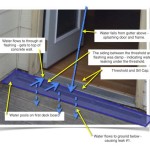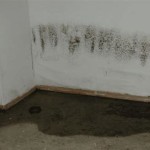How To Get Your Basement to Stop Flooding
Basement flooding can be a significant problem for homeowners, leading to property damage, health concerns, and diminished property value. Understanding the causes of basement flooding and implementing effective preventative measures are crucial for maintaining a dry and healthy home. This article outlines common reasons for basement flooding and provides detailed strategies to mitigate this issue.
Identifying the Sources of Basement Flooding
Before implementing any solutions, it's essential to identify the root cause of the flooding. Common sources include rainwater runoff, groundwater seepage, plumbing leaks, and sewage backups. Accurately diagnosing the problem will allow for targeted and effective remediation.
Rainwater Runoff: Heavy rainfall can overwhelm the ground's ability to absorb water, leading to runoff that accumulates around the foundation of the house. This excess water can then seep through cracks in the foundation walls or floor. Insufficient grading around the house, clogged gutters, and downspouts that discharge too close to the foundation exacerbate this issue.
Groundwater Seepage: The water table level beneath the ground can rise during periods of heavy rainfall or snowmelt. This elevated water table can exert hydrostatic pressure on the basement walls and floor, forcing water through any existing cracks or porous materials. Properties located in areas with high water tables are particularly susceptible to this type of flooding.
Plumbing Leaks: Leaks in water pipes, drain lines, or appliances can contribute to basement flooding. Even small, slow leaks, if left unaddressed, can accumulate over time and cause significant water damage. Faulty washing machines, water heaters, and leaking toilets are common culprits.
Sewage Backups: A clogged or damaged sewer line can cause sewage to back up into the basement through floor drains, toilets, or other plumbing fixtures. This is a particularly serious type of flooding, as it poses significant health risks due to the presence of harmful bacteria and pathogens. Tree roots infiltrating sewer lines are a frequent cause of blockages.
Implementing Preventative Measures Outside the Home
Addressing issues outside the home is often the first and most effective step in preventing basement flooding. Redirecting water away from the foundation and improving drainage can significantly reduce the risk of water intrusion.
Improving Grading and Landscaping: The ground around the foundation should slope away from the house at a rate of at least six inches over the first ten feet. This ensures that rainwater is directed away from the foundation, preventing it from pooling and seeping into the basement. Adding topsoil and re-grading the landscape can correct improper slopes.
Furthermore, landscaping plays a crucial role in water management. Avoid planting water-intensive vegetation close to the foundation. Consider using permeable paving materials for walkways and patios to allow rainwater to seep into the ground rather than running off towards the house. Installing French drains, which are underground perforated pipes, can collect and redirect excess water away from the foundation.
Maintaining Gutters and Downspouts: Clean gutters and downspouts regularly to prevent clogs from leaves, debris, and other materials. Clogged gutters can cause water to overflow and pool around the foundation. Downspouts should extend at least ten feet away from the foundation to direct water away from the house. Consider installing downspout extensions or underground drainage systems to further channel water away from the foundation.
Installing a Sump Pump and Pit: A sump pump is a device designed to remove water that accumulates in a sump pit, typically located beneath the basement floor. The sump pit collects water through a drain tile system installed around the perimeter of the foundation. The sump pump then automatically pumps the water away from the house, preventing it from flooding the basement. Ensure the sump pump is properly sized for the volume of water it needs to handle and has a reliable power source, including a battery backup in case of power outages. Regular maintenance and testing of the sump pump are essential to ensure its proper functioning.
Addressing Issues Inside the Basement
Even with effective exterior measures, water can still find its way into the basement through cracks or other vulnerabilities in the foundation. Addressing these issues from the inside is equally important to prevent flooding.
Sealing Cracks and Foundation Walls: Inspect the foundation walls and floor for cracks, holes, or other signs of damage. Small cracks can be sealed with hydraulic cement, which expands as it dries to create a watertight seal. Larger cracks may require professional repair using epoxy injections or other specialized techniques. Applying a waterproof sealant to the interior of the foundation walls can provide an additional layer of protection against water intrusion.
Installing a Waterproofing Membrane: A waterproof membrane can be applied to the interior of the foundation walls to create a barrier against water seepage. These membranes are typically made of flexible, durable materials that can withstand hydrostatic pressure. They are applied in multiple layers and can be installed as part of a comprehensive basement waterproofing system.
Improving Ventilation and Dehumidification: Moisture in the basement can exacerbate the effects of flooding and contribute to mold growth. Improving ventilation by opening windows or installing a dehumidifier can help to reduce moisture levels and prevent the growth of mold and mildew. A dehumidifier removes excess humidity from the air, creating a drier environment that is less conducive to mold growth.
Preventing Sewage Backups
Sewage backups are a particularly unpleasant and hazardous type of basement flooding. Preventing these backups requires specific measures to ensure the proper functioning of the sewer line.
Maintaining the Sewer Line: Regularly inspect the sewer line for signs of damage or blockage. Tree roots are a common cause of sewer line problems, as they can infiltrate the pipes in search of water. Consider having the sewer line professionally cleaned and inspected every few years to remove any blockages and identify potential problems before they lead to a backup.
Installing a Backwater Valve: A backwater valve is a device installed in the sewer line to prevent sewage from flowing back into the house. This valve allows sewage to flow out of the house but automatically closes if there is a backflow from the sewer main. Installing a backwater valve is a highly effective way to prevent sewage backups, especially in areas with a history of sewer line problems. Local plumbing codes may require the installation of backwater valves in certain situations.
Properly Disposing of Waste: Avoid flushing items down the toilet that can clog the sewer line, such as diapers, sanitary napkins, and grease. These items can accumulate in the sewer line and cause blockages that lead to backups. Dispose of these items properly in the trash to prevent sewer line problems.
Regularly Inspecting and Maintaining Your Basement
Proactive inspection and maintenance are crucial for preventing basement flooding. Regularly inspect the basement for signs of water damage, such as dampness, stains, or mold growth. Address any issues promptly to prevent them from escalating into more serious problems.
Check the sump pump regularly to ensure that it is functioning properly. Clean the sump pit to remove any debris or sediment that may have accumulated. Test the sump pump by pouring water into the pit to ensure that it automatically turns on and pumps the water away. Replace the sump pump every five to seven years, or sooner if it shows signs of wear or malfunction.
Inspect the foundation walls and floor for cracks or other signs of damage. Seal any cracks promptly to prevent water from seeping into the basement. Check the gutters and downspouts to ensure that they are clean and functioning properly. Regularly clean the gutters to remove any leaves or debris that may have accumulated.
By understanding the causes of basement flooding and implementing these preventative measures, homeowners can significantly reduce the risk of water damage and maintain a dry, healthy basement environment. Regular inspection and maintenance are essential for ensuring the long-term effectiveness of these measures.

How To Prevent Basement Flooding Complete Strategy

6 Simple Ways To Prevent Basement Flooding American Dry

8 Tips For Flood Proofing A Basement

The Best Ways To Prevent Basement Flooding Swartz Restoration And Emergency Services

How Sump Pumps Prevent Basement Flooding Md Plumbing

How To Prevent Basement Flooding Woodard

Here S How To Prevent Basement Flooding Reviewed

How To Prevent Basement Flooding

How To Clean A Flooded Basement Reviews By Wirecutter

Tips For Handling Water In Your Basement Zoeller At Home







